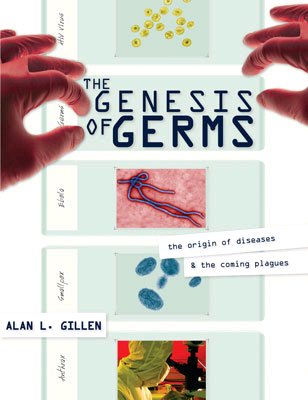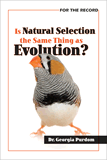
Chapter 1
Is Antibiotic Resistance Proof of Evolution?
Section 4
Antibiotic resistance is one of the most important topics that a beginning biology student going into medicine should learn and understand. Antibiotic resistance is one of the so-called facts of “evolution.” In this section, we will see that it is indeed a “fact” of change, but not one of real evolution (i.e., neo-Darwinian evolution). Antibiotic resistance has become one of the most serious problems to confront modern scientists. The first known antibiotics were produced by fungi, notably those from the mold Penicillium chrysogenum (see chapter 5 on fungi). An antibiotic is a substance produced by a microbe that, in small amounts, inhibits another microbe. However, today most antibiotics are produced by bacteria (esp. Streptomyces), not molds. Antibiotics have become the miracle drugs of the 20th century and have greatly reduced infectious disease and lengthened the life of man.
During the last 50 years, an alarming number of bacteria species have developed resistance to antibiotics. These resistant organisms are increasingly responsible for human diseases of the lungs, intestinal tract, blood, and the genitourinary tract. They are of special danger to those in burn and intensive care units, those with compromised immune systems, children, and the elderly. Among the most difficult diseases to treat are those that once succumbed to small doses of antibiotics, such as staphylococcal and streptococcal infections, bacterial STDs (e.g., gonorrhea), bacterial pneumonia, and tuberculosis (Table 1.1).
| Table 1.1 - Antibiotic resistance and major medical problems for: |
|---|
| 1. Enterococci (vancomycin-resistant enterococci) |
| 2. Staphylococcus aureus (methicillin-resistant Staphylococcus aureus) |
| 3. Streptococcus pneumoniae (penicillin-resistant) |
| 4. Mycobacterium tuberculosis (multiple-drug resistant to first-line drugs) |
Microbes have acquired resistance to antibiotics in a number of ways (Table 1.2). With some antibiotics (e.g., penicillin) resistance arises from the microbe’s ability to destroy the antibiotic before the antibiotic destroys the microbe. Resistance may occur in bacteria during the normal course of events, as happened with penicillinase-producing bacteria. Resistance can also arise from changes in the pathways of the microbial cell wall and membrane that restrict movement of the antibiotic into the cytoplasm. Alternatively, a microbe may alter the metabolic pathway on which an antibiotic normally acts and thereby bypass the drug inhibition. Resistance may also develop when a bacterium changes the target of the antibiotic (e.g., tetracycline), such as by changing the structure of its ribosome.
| Table 1.2 - Mechanisms that can lead to antibiotic resistance, including: |
|---|
| 1. Enzymatic destruction of drug |
| 2. Prevention of penetration of drug |
| 3. Alteration of the drug's target site |
| 4. Rapid ejection of the drug |
| 5. Resistance genes on plasmids or transposons that can be transferred between bacteria |
An alarming number of bacterial species have developed resistance to one or more antibiotics. The one of greatest concern over the past five years is S. aureus. The most notable feature of staphylococcal skin disease is a boil, or an abscess, a pus-filled lesion. More widespread staphylococcal diseases are pneumonia, septicemia, endocarditis, and meningitis. S. aureus is involved in over 250,000 infections per year, primarily in hospitals and nursing homes. Staphylococcal diseases are usually treated with penicillin, but over the years, strains of S. aureus have developed resistance to penicillin and numerous other antibiotics.
Multidrug-resistant Staphylococcus aureus (MRSA) has become a common problem in ambulances, emergency rooms, hospital wards, and clinics. Through those years, vancomycin remained a viable alternative for treating MRSA infections, even though it is a very expensive and somewhat toxic antibiotic. It was known as the drug of last resort. Then, in 1997, an MRSA strain emerged with partial vancomycin resistance. Although microbiologists and physicians have found useful treatment alternatives in drug combinations during the 1990s, they were grappling with the possibility that one day there will be no antibiotic to treat patients infected by MRSA. The concern was so acute because vancomycin-resistant enterococci exist in the human intestine, and gene transfers to S. aureus strains are possible.
The major drug that came in response to increasing MRSA infections is Synercid. Synercid is the first antibiotic approved for treatment of patients with serious or life-threatening infections associated with vancomycin-resistant Enterococcus faecium (VREF) bacteremia. Synercid is also approved for complicated skin and skin structure infections caused by Staphylococcus aureus (methicillin-susceptible) or Streptococcus pyogenes.
This drug helped to ease hospital concerns in 2005, but it has its limitations. The ongoing concern comes from the observation that antibiotic-resistance genes are frequently found on easily transmitted plasmids. Each year, pharmaceutical companies look for new and effective antibiotics to treat MRSA and other serious bacterial infections. There will always be a need for new antibiotics due to human activities (Table 1.3) and the ongoing change (variation) of bacteria.
| Table 1.3 - Misuse of antibiotics that selects for resistance mutants includes: |
|---|
| 1. Using outdated, weakened antibiotics |
| 2. Using antibiotics for the common cold and other inappropriate conditions |
| 3. Use of antibiotics in animal feed |
| 4. Failure to complete the prescribed regimen |
| 5. Using someone else’s leftover prescription |
The most common mechanism of transfer is through the conjugative transfer of R plasmids. R plasmids frequently carry several resistance genes, each mediating resistance to a specific antibiotic. Thus, when a bacterium acquires R plasmid, it acquires resistance to several medications simultaneously. If a bacteria strain has multiple resistance factors, it is frequently known as a “superbug.” These superbugs are troublesome in many hospital and clinical settings.
Resistance is not really new. Although reported only since the 1940s, resistance has existed in nature for thousands of years. There is “warfare” in the soil between bacteria and fungi and among bacteria. Most likely after the Edenic curse, such processes as intermicrobial transfer of plasmids containing resistance genes (R factors), conjugation, transformation, and transduction started to occur. One of the most convincing studies that demonstrate that bacteria become resistant to antibiotics through “old” genes present in the past was published in 1988. In that study, individual bacteria from the intestines of explorers who had been frozen before the development of antibiotics were shown to already be resistant to several antibiotics that had not been developed until after the explorers were frozen. Thus the genes that produced resistance were already there. Thus, it is very likely that kind of antibiotic resistance has been in nature for a long time.
One Microbiologist Reported
Scientists at the University of Alberta have revived
bacteria from members of the historic Franklin expedition who mysteriously perished in the Arctic nearly
150 years ago. “Not only are the six strains of bacteria
almost certainly the oldest ever revived,” says medical
microbiologist Dr. Kinga Kowalewska-Grochowska,
“three of them also happen to be resistant to antibiotics. In this case, the antibiotics clindamycin and cefoxitin, both of which were developed more than a century
after the men died, were among those used.”
—Ed Struzik, “Ancient Bacteria Revived,” Sunday Herald, September 16, 1990.
Antibiotic Resistance and Evolution
Exposure of a bacteria population to a specific antibiotic (e.g., penicillin, methicillin, etc.), whether in a person or in a Petri dish) will kill antibiotic sensitive bacteria (S. aureus), but not those that happen to have R plasmids to counteract that antibiotic. According to the theory of natural selection, biologists predict that under these circumstances the bacteria carrying genes for antibiotic resistance will increase. This event happens frequently and is declared by Darwinists as the “fact” of evolution. It is a fact of change, but it is not a fact of neo-Darwinian evolution. According to creation microbiologist and Director of the CRS Van Andel Creation Research Center, Dr. Kevin Anderson,
Evolutionists frequently point to the development of antibiotic resistance by bacteria as a demonstration of evolutionary change. However, molecular analysis of the genetic events that lead to antibiotic resistance do not support this common assumption. Many bacteria become resistant by acquiring genes from plasmids or transposons via horizontal gene transfer. Horizontal transfer, though, does not account for the origin of resistance genes, only their spread among bacteria. Mutations, on the other hand, can potentially account for the origin of antibiotic resistance within the bacterial world, but involve mutational processes that are contrary to the predictions of evolution. Instead, such mutations consistently reduce or eliminate the function of transport proteins, protein binding affinities, enzyme activities, and/or regulatory control systems. While such mutations can be regarded as “‘beneficial,” in that they increase the survival rate of bacteria in the presence of the antibiotic, they involve mutational processes that do not provide a genetic mechanism for “descent with modification.”
Anderson goes on to demonstrate how some “fitness” cost is often associated with mutations, although reversion mutations may eventually recover most, if not all, of this cost for some bacteria. A biological cost does occur in the loss of pre-existing cellular systems or functions. Such loss of cellular activity cannot legitimately be offered as a genetic means of demonstrating evolution, but is rather evidence of devolution.
Avian Flu Is Due to Genetic Reassortment and Variation of RNA
We frequently hear and read about microbes in the news. According to Scientist magazine, the number two story in all science for the year 2005 was about “bird flu.” In all history, more deaths have been attributed to microbes than any other cause. Influenza is an ancient disease that has infected humans at irregular intervals throughout recorded history. Symptoms of flu include fever (usually high), headache, extreme tiredness, dry cough, sore throat, runny or stuffy nose, and muscle aches. In some cases, gastrointestinal symptoms, such as nausea, vomiting, and diarrhea, occur among children (very rarely in adults). Most related deaths are due to pneumonia and respiratory failure. While the 1918 “Spanish” influenza is the best recorded catastrophic influenza pandemic, similarly severe pandemics occurred earlier, when the human population of the world was much smaller, and they will occur again. Our challenge is to understand all aspects of the influenza virus, the hosts and their response, and the virus’s global impact so that we may be better prepared to face the inevitable next influenza pandemic.

Influenza virus
The main reason for major changes in influenza is an antigenic shift. This means there has been a major exchange of chromosomes from one flu virus type to another type. Frequently, the domestic pig has been a “mixing vessel” for wild avian and human flu strains. New strains of influenza come to people after they are exposed. It is a genetic reassortment of genes (namely hemagglutinin [H] and neuraminidase [N]) that get exchanged. It is not an evolution of new genetic material. The RNA gets dealt in different ways in birds, mammals, and people. Sometimes the changes are minor and sometimes they are major. These major ones are often the reason for threats of global pandemics. The same concept applies in domestic chickens—they have become a “mixing vessel” between wild birds and people.
The influenza virus that appears most threatening is the avian H5N1 strain that since 2003 has infected more than 130 persons in Vietnam, Thailand, and Cambodia, and has killed more than half of them. Nonetheless, the H5N1 influenza threat is viewed with disturbing complacency; a frequently heard statement is, “since the virus has not adapted to continuing human-to-human transmission by now, it is unlikely to do so in the future.”Such complacency is akin to living on a geologic fault line and failing to take precautions against earthquakes and tsunamis.
According to Dr. R. Webster,
Ongoing outbreaks of H5N1 avian influenza in migratory water fowl, domestic poultry, and humans in Asia during the summer of 2005 present a continuing, protean pandemic threat. We review the zoonotic source of highly pathogenic H5N1 viruses and their genesis from their natural reservoirs. The acquisition of novel traits, including lethality to waterfowl, ferrets, felids, and humans, indicates an expanding host range. The natural selection of nonpathogenic viruses from Influenza virus heterogeneous subpopulations co-circulating in ducks contributes to the spread of H5N1 in Asia. Transmission of highly pathogenic H5N1 from domestic poultry back to migratory waterfowl in western China has increased the geographic spread. The spread of H5N1 and its likely reintroduction to domestic poultry increases the need for good agricultural vaccines. In fact, the root cause of the continuing H5N1 pandemic threat may be the way the pathogenicity of H5N1 viruses is masked by co-circulating influenza viruses or bad agricultural vaccines.
The Unseen World Summary
Microbes are here by design. They are not God’s mistakes. Microbes have not evolved; they were created with purpose. Microbes as “whole”organisms benefit the environment and mankind. Microbes, especially bacteria and their molecular motors and irreducibly complex processes, shout creative, intelligent design. Bird flu and antibiotic resistance are examples of variation, not neo-Darwinian evolution.
Microbiology is relevant to the educated layperson and to the health professional. Microbes affect our lives. Later chapters will explore bacteria, fungi, protozoans, viruses, microbial genetics, emerging diseases, and the origin of disease in more depth. Disease is a consequence of the fall of man. The Edenic curse led to degeneration, corruption, disease, and decay. God has given man both the command to have dominion over the earth and to conquer disease—to heal the sick. These are topics for later chapters.
The Genesis of Germs
Professor Alan Gillen shows that constantly mutating diseases are proof for devolution rather than evolution.
Read OnlineRecommended Resources

Answers in Genesis is an apologetics ministry, dedicated to helping Christians defend their faith and proclaim the good news of Jesus Christ.
- Customer Service 800.778.3390
- © 2024 Answers in Genesis



